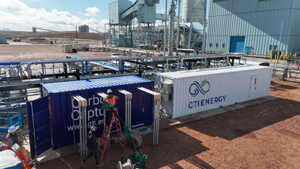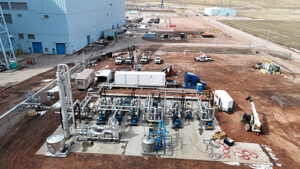Reducing the Cost of Carbon Capture with Facilitated Transport Membrane (FTM) Technology
 GTI Energy is collaborating with the U.S. Department of Energy National Energy Technology Laboratory (DOE-NETL), the Ohio State University (Ohio State) and other partners to develop and scale up a CO2 capture process based on novel, transformational membrane technology.
GTI Energy is collaborating with the U.S. Department of Energy National Energy Technology Laboratory (DOE-NETL), the Ohio State University (Ohio State) and other partners to develop and scale up a CO2 capture process based on novel, transformational membrane technology.
The $21 million project comprises fabricating facilitated transport membranes (FTM) and membrane modules, designing and building an engineering-scale CO2 capture system with a 20-tonne per day CO2 capture capacity, conducting extensive tests on actual power plant flue gas at the Wyoming Integrated Test Center (ITC) located adjacent to Basin Electric’s coal-fired Dry Fork Station in Gillette, Wyoming. The project sets the FTM technology up for large-scale demonstrations to mitigate the risk of scale-up to commercial deployment.
GTI Energy is also partnering with Ohio State to design and build a 3-tonne CO2 per day engineering-scale test skid for testing at a Holcim U. S. cement plant in Holly Hill, South Carolina.
 Lowering the cost of CO2 capture technology and gaining operational experience is crucial for wider adoption of CO2 capture, utilization, and storage. Capturing CO2 from power production and industrial gas streams, such as in cement and steel production, can create immediate economic value through enhanced oil recovery, while at the same time demonstrating the potential of the technology to reduce greenhouse gas emissions from fossil fuel use long-term as part of a reliable, affordable, and sustainable energy system. Membrane systems are attractive in these applications because they are well proven in industrial gas separation applications, inherently modular in nature, can be operated in a flexible manner, and avoid the handling of hazardous materials as well as other environmental challenges such as solvent emissions that are associated with more conventional, solvent-based CO2 capture approaches. The FTM technology in particular is a step out in its unmatched CO2 separation performance and has the potential to be the lowest cost CO2 capture option across the power and industrial sectors.
Lowering the cost of CO2 capture technology and gaining operational experience is crucial for wider adoption of CO2 capture, utilization, and storage. Capturing CO2 from power production and industrial gas streams, such as in cement and steel production, can create immediate economic value through enhanced oil recovery, while at the same time demonstrating the potential of the technology to reduce greenhouse gas emissions from fossil fuel use long-term as part of a reliable, affordable, and sustainable energy system. Membrane systems are attractive in these applications because they are well proven in industrial gas separation applications, inherently modular in nature, can be operated in a flexible manner, and avoid the handling of hazardous materials as well as other environmental challenges such as solvent emissions that are associated with more conventional, solvent-based CO2 capture approaches. The FTM technology in particular is a step out in its unmatched CO2 separation performance and has the potential to be the lowest cost CO2 capture option across the power and industrial sectors.
The FTM membranes have previously been validated for stability and performance in controlled lab experiments and under actual power plant flue gas conditions in extensive tests at the National Carbon Capture Center in Alabama under a U.S. Department of Energy collaboration.
Learn more about Facilitated Transport Membrane Technology
Learn More
Contact the energy experts today
